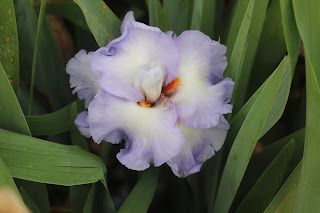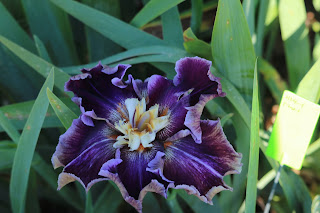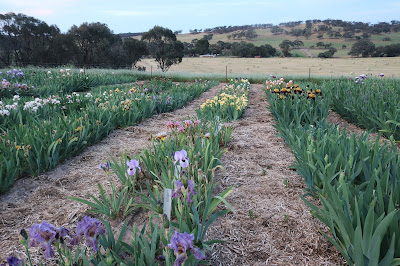by Mel Schiller
Whoever would have thought that our spring would be so incredibly wet!
We had an unbelievable amount of rain. Getting good photos was a challenge in between rain, wind, and soggy-looking bloom. Living on one of the driest continents on earth, which has a fluctuation in temperature and rainfall, we are certainly not complaining!
Every year we are faced with challenges – challenges in growing conditions, challenges in weather, challenges in pests. Challenges are a part of life. How we overcome them is how we grow on a personal and business level.
The season that was .... Braiden's death anniversary is forever in our hearts as the beginning of our iris season. My mind in particular is consumed with the loss of my child; it is a heavy burden. Each year it is something I need to allow and grow from in my heart and mind.
The iris were late coming into bloom as the season was so cold and damp. Sunshine was hard to come by. Then WHAM!, the bloom started all at once.
We had a hard time keeping up with photographs, hybridizing, and evaluating. Our iris field is spread out over five acres. We also had some of our last hybridizing efforts from the USA blooming in a different section of the garden.
We were able to evaluate seedlings on wet days and sunny days. This led to a lot of decisions about what to keep going for future evaluation and what to dispose of as not up to standard: poor bloom and stems, and diseased foliage, just to name a couple problems.
The last year of evaluation for the USA seedlings
This past spring was also the year that South Australia hosted the National Iris Convention. We had a one-day show in which we benched over 150 stems, florets, and seedlings among all the different classes.
We wrapped our buds in toilet paper to protect them from the long travel to Adelaide where the iris show was held. Then we placed our entries in a big tub with dampened floral foam in the bottom and inserted the stems in the foam to hold them safe (hopefully). On the day of the show, we awoke to a foggy morning!
We were incredibly proud of ourselves for being able to supply bloom for all classes in the show. For the first time ever, we were able to provide standard dwarf, intermediate, and aril entries! We received 2nd and 3rd in the show with two of our very own hybrids: '
Dreaming Easy' and '
Zofonic Dancer.' '
Victoria Falls' grown by Jennifer, took home Champion of the Show.
The very next day Smokin Heights hosted the National Iris Convention attendees. We awoke from our sleep throughout the night to on- and off- again torrential rain. At 7 a.m. the phones were ringing hot. Major flooding was occurring in all the areas that the tour group was supposed to visit. The group eventually made it to Smokin Heights just after a late lunch. With rain patches still occurring, the group managed a tour of Smokin Heights and the soggy field. Bailey was able to lead a tour of our seedling patch in between rain showers.
National Iris Convention for Australia attendees!
The very next day was lovely and bright, full of hope and promise with an amazing sunrise!
The Intermediate and Dwarf Bearded irises bloomed exceptionally well this past season
Performing hybridizing was a task in itself this past season. Wet pollen and soggy stigmatic lips were a popular problem! We have managed to collect around 400 pods of hybridized iris from our field stock – not bad considering the wet season!
 |
| Iris seeds from our hybridizing efforts |
 |
| More hybridizing seeds |
 |
| New, imported irises from off the delivery truck and onto our lawn area |
We looked forward to receiving our imported iris from the USA. In February, they were finally released from quarantine. Australia has incredibly strict rules for importing bearded irises into our country. Importing is not for the faint-hearted; it is a costly, time-consuming, and stressful job! But this effort is worth it for irises we would like to use genetically in our hybridizing program.
A small portion of the field photographed this past week
The field will not be dug and replanted this year. There is enough room for increase and growth to postpone a replant. Instead, plants will remain in place while we apply fertilizer (for nutrients) and pre-emergent herbicide (for weed control) over the next couple of months.
The following is a small selection of new varieties hybridized by Bailey and me:
(Inner Darkness X Black Lipstick)
(Secret Status X Raise Your Glass sibling)
(complex ancestry)
(complex ancestry)
(Seasons In The Sun X Carnival Capers)
(Troublemaker X Stop And Stare)
The small selection of iris we registered this season withstood our unusually wet conditions superbly. Now that we have finalized business orders we can plan for our next season. We also celebrate ten years of Smokin Heights. Bailey and I are so very grateful and appreciative of our accomplishments. Every day is a blessing and we have our garden to enjoy and nurture.
It is now time to weed the garden beds as they have been unattended for the last few months. Weeds are plentiful! Time for us to enjoy solace in our garden.
Happy Gardening
.JPG)
.JPG)
.JPG)
.JPG)
.JPG)

.JPG)
.JPG)
.JPG)
.JPG)

.JPG)

























.JPG)

.JPG)
.JPG)
.JPG)
















